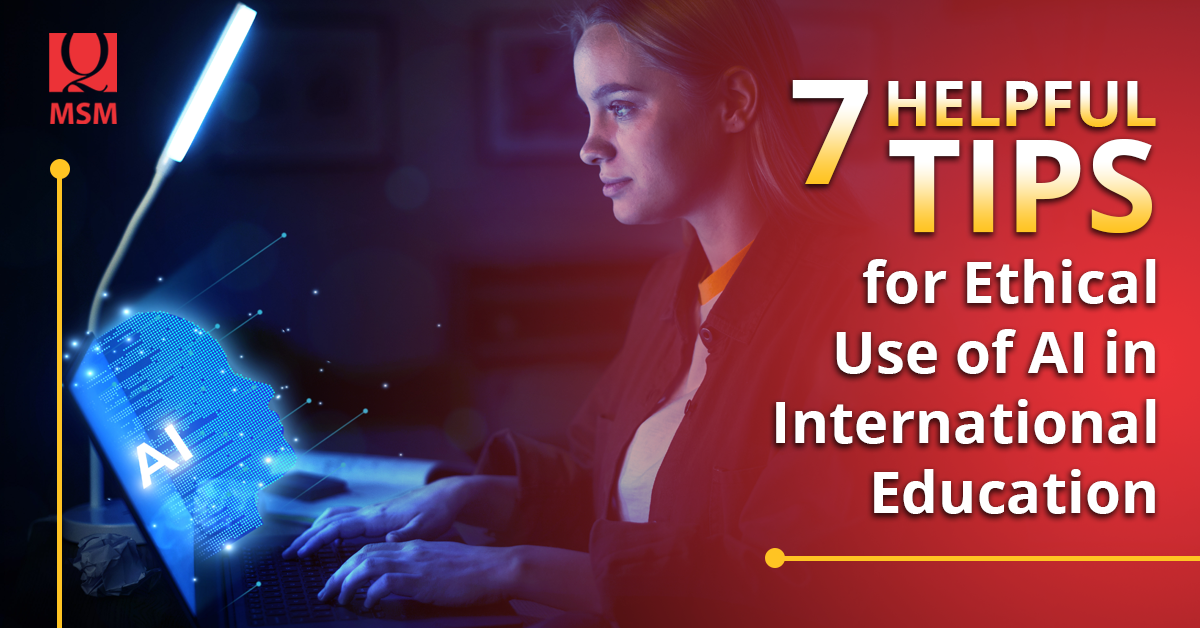The proper application of artificial intelligence (AI) represents a critical frontier in the field of international education. The need for ethical AI use is becoming more crucial as legislators, administrators, and educators deal with the challenges of incorporating AI into various cultural and educational contexts. This article aims to promote the ethical practices of AI in international education environments.
Educational institutions may leverage AI to improve global collaboration, cross-cultural learning experiences, and inclusive learning environments by emphasizing ethical issues, fostering AI literacy among educators, and including stakeholders in AI governance.

Ensuring data protection and security, keeping an eye on the effects of AI interventions, and enabling educators to innovate responsibly are essential elements of successful AI integration as the digital landscape changes. By trying these seven helpful tips, colleges, and universities can use AI to enhance student learning and teaching while still preserving moral principles, encouraging diversity, and equipping students with the skills they need to succeed in a globalized society.
1. Welcome Cultural Diversity
When integrating AI into international education settings, it’s crucial to consider the diverse cultural backgrounds of students and educators. Ensure that AI tools are culturally sensitive and inclusive, respecting various perspectives and learning styles. One example of these tools is Woolaroo, a free tool developed to aid language communities in maintaining and growing their word lists.
2. Promote Global Collaboration
Make use of AI as a catalyst to encourage international cooperation between instructors and students from other nations. Promote the use of AI-powered communication technologies to help with cooperative projects, cross-cultural interactions, and group problem-solving. The SuperNormal tool, for example, facilitates the simple review, sharing, and referencing of important issues mentioned by participants by automatically transcribing and analyzing meeting information.
3. Prioritize Ethical AI Practices
Give ethical considerations a priority while developing and implementing AI to encourage responsible use. In all AI-related activities, we must emphasize the significance of responsibility, fairness, openness, and privacy protection.
4. Empower Educators with AI Literacy
Give educators thorough instruction and opportunities for professional growth to improve their AI literacy and competency. Provide them with both the information and abilities they need to safely incorporate AI into their teaching methods while avoiding biases and hazards.
5. Ensure the Involvement of Stakeholders in AI Governance
Create systems to involve different stakeholders in the governance of AI in education, including students, parents, teachers, legislators, and community members. To guarantee that AI projects are in line with community needs and values, promote candid communication, feedback channels, and collaborative decision-making procedures.
6. Promote Data Privacy and Security
To safeguard sensitive data gathered and processed by AI systems in educational contexts, put strong data privacy and security controls in place. Inform stakeholders of their rights about data privacy and give them the tools they need to make wise decisions about disclosing personal information.
7. Monitor and Evaluate the Impact
Continue to track and assess how AI interventions affect student welfare, educational equity, and teaching and learning results. To improve AI tactics, handle new issues, and optimize the advantages of AI in international education, apply evidence-based insights. For instance, The Conversation recently published an article on whether AI is helpful or not in a student’s creativity.
Schools may embrace the revolutionary potential of AI while maintaining ethical standards, encouraging inclusion, and equipping students to survive in a rapidly changing world by executing these strategies for responsible AI use in education.
Source
- Habib, S. (2024, February 1). AI can help − and hurt − student creativity. The Conversation. Retrieved from https://theconversation.com/ai-can-help-and-hurt-student-creativity-220587
- Supernormal – AI that writes your meeting notes. (2024, February 16). Supernormal Technologies, Inc. Retrieved from https://supernormal.com/
- Tucker, C. (2024, January 31). How school leaders can pave the way for productive use of AI. Edutopia. Retrieved from https://www.edutopia.org/article/setting-school-policies-ai-use
- Woolaroo. (2024). Woolaroo. Retrieved from https://artsandculture.google.com/project/woolaroo



